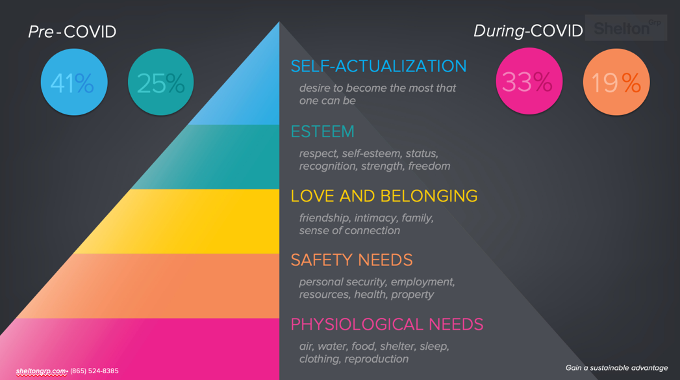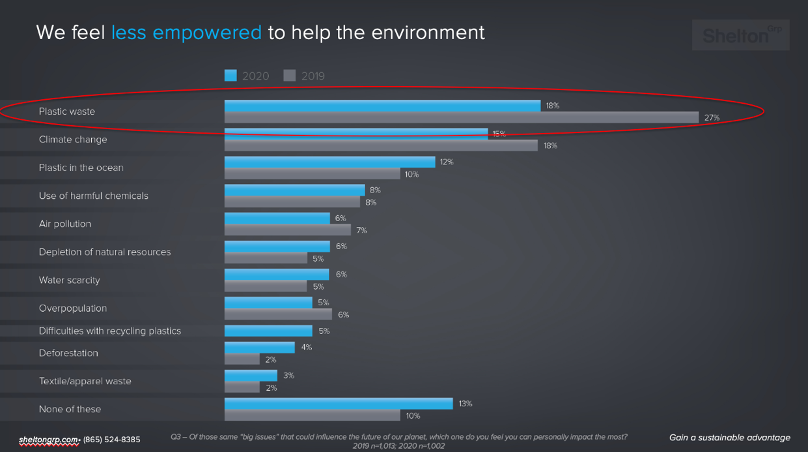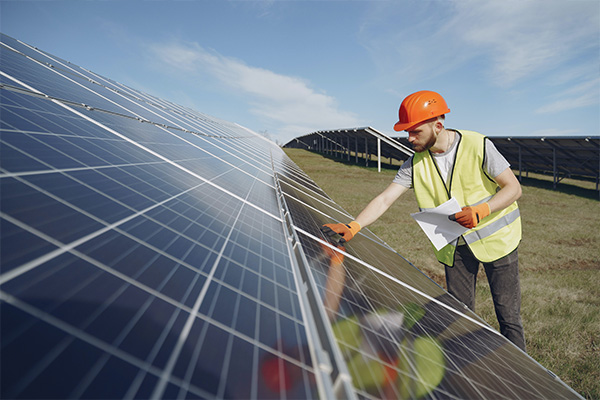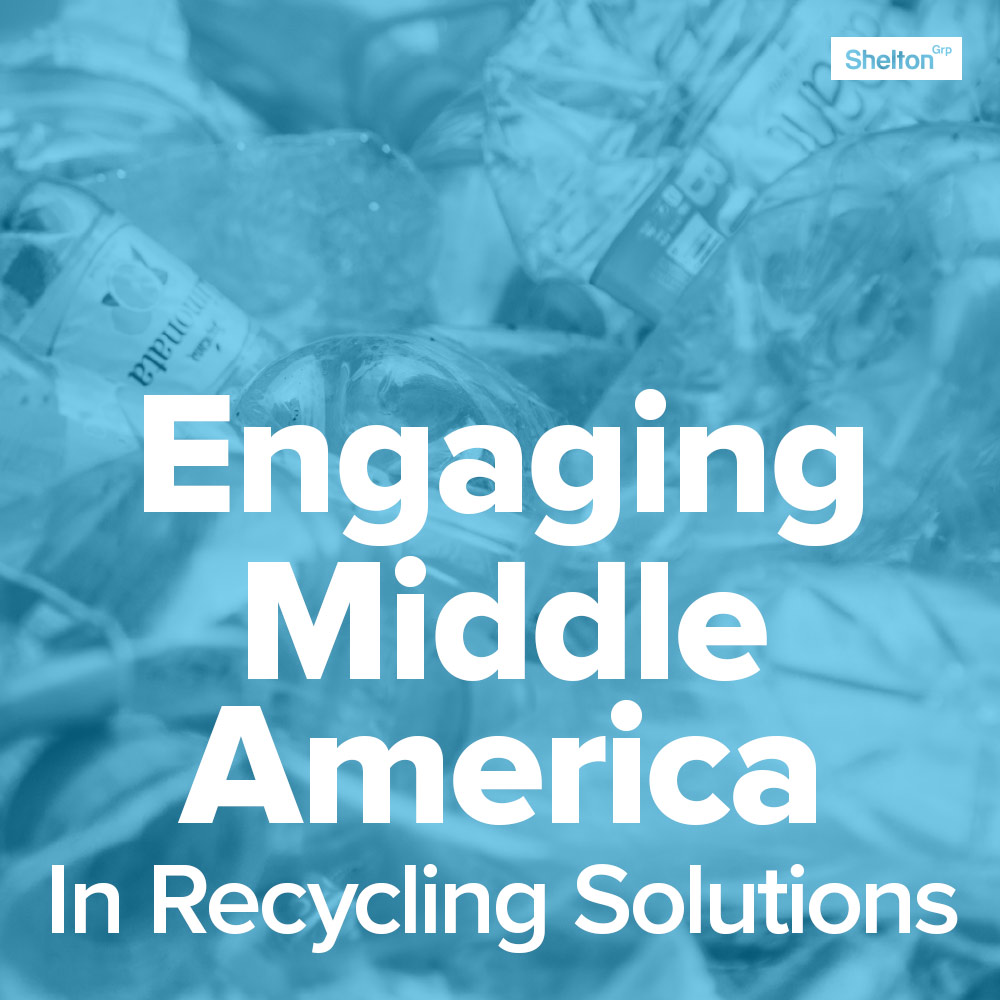Engaging Middle America in Recycling Solutions:
The challenges & opportunities
Shelton Stat of the Week
Only 18% of Americans feel they can do something about plastic waste, down from 27% last year.
A few weeks ago, I wrote a post about what Maslow’s Hierarchy of Needs can teach us about the moment we’re in right now, based on our latest polling of Americans. At Circularity 2020 I talked about how to engage people in recycling, and the two ideas are linked together. (You can download a free report with more detail on all of it by clicking here.)
The gist is that we can’t self-actualize as the people we want to be if we’re not getting our basic needs met. Pre-COVID, 41% of us wanted to be seen as someone who buys green products, and 25% of us could cough up an example, unaided, of a brand we’d purchased or not purchased because of the environmental record of the manufacturer. As of late May 2020, smack in the middle of the pandemic, these numbers dropped dramatically, down to 2013 levels at 33% and 19% respectively.

In the rock, paper, scissors game of survival, we just can’t take action on higher-level things when we’re worried about meeting our basic needs. And we’re really worried about getting our basic needs met. Worries about the health of the economy and human health far outweigh concerns about the environment right now.
This was not the case pre-pandemic. We were just as worried about plastics in the ocean and climate change in early March as we were last summer…but that concern plummeted in May. Think about it like this: we decided to take a cross-country road trip in a car with a transmission that’s on its last legs, so the whole time we’re driving we’re worried about the transmission failing. Then all of a sudden – boom – we get a flat tire. Now we’re not worried about the transmission anymore. Coronavirus is the flat tire, and once we can get it repaired and drive on it long enough to be sure it’s not going to go flat again, we’ll start worrying about the bigger transmission issue – the environment.
For now, though, we feel disempowered and unable to do much about the environment.
For instance, last summer the one environmental issue 27% of us felt we could actually do something about – plastic waste – has backslid in a major way. Only 18% of us believe we can do anything about it now – and that’s the number one answer!

Not surprisingly, then, we’re less activated on trying to avoid single-use plastics. Last year one-third of Americans said they were actively trying to buy products packaged in something other than plastic and urging friends and family to do the same; as of May, only a quarter of us are now doing that.
Remember that so much of the outrage about plastics in the ocean is the fact that plastics are now in our food stream, so it’s a human health issue. We now have a more pressing, immediate human health issue to deal with – as well as a pressing social equity crisis and economic crisis – so we’ve become less activated on single-use plastics. In fact, you might say that the Great Awakening of our massive systemic issues — spurred by COVID-19 and the murder of George Floyd – has allowed us to go to sleep, for the moment, on the environment.
One last thing for context: with all the noise about the economy, coronavirus, politics, etc., we’re all hearing less about every single environmental issue we track. For instance, last year 63% of Americans said they had heard about bans on single-use plastic. Now that number is down to 54%.
So, there’s something to be said for continuing to communicate about environmental issues, and there’s something to be said for demonstrating the behaviors you want people to adopt – both have a correlated impact on consumer action. And, again, it’s going to be hard to motivate action on our environmental transmission while we’ve got an economic and health-related flat tire.
So, what does this mean for engaging Americans in recycling?
If we don’t feel like we can actually impact the plastic waste issue – and some of us have gone to sleep in terms of our habits and actions – what does this mean for recycling?
Are we less inclined to throw our recyclables in the bin because we feel so disempowered or worried about the economy and anxious about keeping our families from catching COVID? And are we aware of the issues in the recycling market – that China won’t take our recyclables anymore and that the American recycling system is in turmoil? If Americans are aware, does that impact their willingness to do their part?
Well, it’s a good news/bad news scenario.
In the good news column, the vast majority of Americans (80%) believe recycling is the bare minimum they can do for the environment, and it makes them feel better about all the stuff they buy. And, by the way, 77% of Americans say they recycle via a curbside pickup service. So, they’re “in” on the current system of throwing stuff in the blue bin and rolling it to the curb.
Some other good news: only 30% have really heard about some cities discontinuing curbside recycling programs. And only 10% say their curbside recycling services have been discontinued.
So, about a third of us are aware something’s going on with our recycling system, but the vast majority of us are happy to keep going along with our curbside guilt-assuaging approach to waste management.
And it is a guilt-assuaging system. While roughly half of us have made some changes to reduce the amount of single-use plastics we buy, plastic is the number one material we all think is easiest to process into a substance that can be used to make a new product or packaging.
And while 40% of us correctly answer that plastics coded number 1, PET, are the easiest for recycling centers to process, 38% of us have no idea which number is easiest to recycle, and the remainder of us answer incorrectly.
Consequently, we’re opinionated about plastics but blissfully ignorant about them, and we let ourselves off the hook for doing anything different in our purchasing because of the current curbside system.
So, what happens when the municipal curbside system fails, as it’s starting to do?
In this case, knowledge or awareness is not correlated to behaviors. 39% of us have heard about other countries no longer accepting our recycling…and, of those folks, 97% say it hasn’t changed their recycling habits. Overall, 77% of us believe that what we put in the bin actually gets recycled. (Though it’s worth noting that’s down from 88% the year before.)
In other words, we’re still chucking stuff in the bin with few worries about whether or not that stuff’s actually being recycled.
We can laugh an ironic laugh at their ignorance…or we can look at this as extremely good news. We worked HARD to get them to adopt recycling behaviors and to adopt the idea that it’s the bare minimum they can do to do their part. And it’s sticking…in fact, they’re clinging to it. The last thing we want is for them to throw in the towel, which is what they’re doing in places where curbside has been discontinued. Of the 10% who say their curbside programs have been discontinued, 56% say they no longer recycle.
So, if we want to engage Americans in recycling, here’s what we need to do:
- We need to continue communicating about – and demonstrating action – on plastic waste.
Remember, we’re all hearing less about environmental issues and noticing fewer bans on plastic waste and fewer actions taken by retailers and restaurants on plastic waste…and that has a direct correlation to our own awareness and action. We need to keep the steady drumbeat of communications and action going if we want to bring people along. - We need to continue our curbside programs and make them really work.
When these go away, we will see a massive backslide in recycling behaviors. This means we need to ensure that our system works, so what gets thrown in the bin actually gets recycled. Given that that will require massive infrastructure changes (and probably policy changes as well), as a stopgap we need to:- Teach Americans to “look before they toss.”
Only 22% actually look at the label on an item to see if it’s recyclable before chucking it in the recycling bin. Most haven’t noticed the new How2Recycle® label or find it too hard to read. We need a massive campaign on this. - Teach them what’s actually recyclable.
Back to the earlier point, many consumers feel bad about using single-use plastics, so their tactic for assuaging their guilt is to throw everything into their bins. That means they’re throwing in a lot of things in that aren’t actually recyclable, which is rooted in a pretty big lack of understanding of what’s actually recyclable. For example, when shown pictures of various types of used packaging and asked what should be done with them – put them in the recycling bin, the trash bin or some combination – Americans don’t pick the right answer as often as you’d hope. My favorite is the plastic creamer bottle with the plastic sleeve/wrap around it. 69% say they’d put the entire package in the trash can, 22% say they’d put the entire package in the recycling container, and 9% say they’d put parts of it in the trash can and parts of it in the recycling container. So, 91% of Americans get this wrong, despite these bottles having a How2Recycle label displayed, telling them what to do.
- Teach Americans to “look before they toss.”
The point is that Americans have a mixed level of understanding about what’s recyclable and what’s not. And despite the progress made by getting the How2Recycle label on so many products, it’s just not enough. We either have to teach them to look before they toss and help them see what’s actually recyclable, OR, better, encourage them to put it all in the Blue Bin and upgrade our recycling system and technologies so that it all actually gets recycled.
Want to learn more about all of this? Download a free copy of the full report here and let us know what you think!

Should ESG Still Be a Priority Post-Pandemic? – Chief Executive
If ESG were only about reusable cups and electric cars, then we may find ourselves looking forward to a post-pandemic future that doesn’t hold much space for such initiatives — initiatives that address serious yet not (immediately) life-threatening matters. But ESG isn’t just about that. “ESG encompasses any and all risks to long-term sustainable value — which is why it won’t be going away,” says Sarah Fortt, a securities lawyer for Vinson & Elkins. Sustainability issues are human issues, and if ever there was a time to focus on human issues, it’s now. Learn about the future of ESG. Read more…

Solar Panels Are Starting to Die. Will We Be Able to Recycle the E-Waste? – EcoWatch
Solar technology evolves fast and the vast majority of panels out there are becoming obsolete. New higher-performing and less expensive technology is replacing the old but where will all those panels go? As utilities companies begin replacing panels in their solar farms and homeowners begin replacing their rooftop panels, they must have somewhere to go. It just doesn’t seem right to send solar panels — the whole existence of which was envisioned to save energy and preserve the planet — to the landfill to waste away. Will solutions be created if the cost exceeds the revenue? Read more…
Engaging Middle America In Recycling Solutions
Before COVID-19, 41% of Americans wanted to be seen as someone who buys green products, and many could cite an example of a brand they’d purchased (or not purchased) because of the environmental record of the manufacturer. Now, in the middle of the pandemic, the numbers have dropped dramatically. The big question is, what does this mean for engaging Americans in their number one green activity: recycling? Another question is, what does it mean for companies’ sustainability brand?
Our latest report answers these questions by digging into current consumer attitudes, how they impact consumer behavior, and how organizations should respond to ensure recycling – and other green behaviors – keep happening.


TAGS:Corporate Sustainability, Environmental Issues